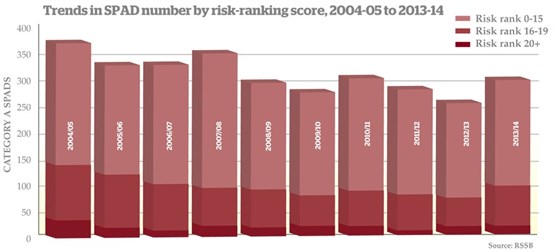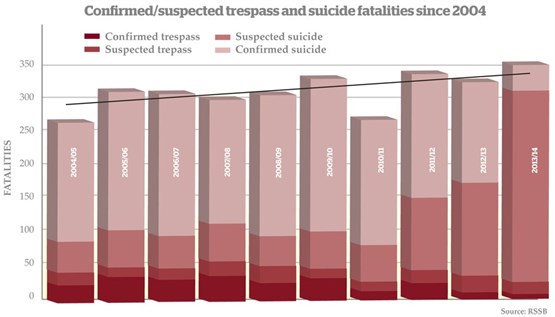Principally that means Network Rail has been installing more robust fencing at the most appropriate sites, particularly on the West Coast Main Line.
Off the pace
Prosser says that the rail industry’s occupational health programme is “some way off the pace” compared with other sectors, such as the petro-chemical industry in which he worked for 18 years.
“Other companies focus enormously on getting safety built into the design of everything new. On the railway we tend to use a tried and tested design because that is what has worked in the past. We have to move on from that. We need a new mindset to make things better from the get-go.
“The industry is good in a crisis - look at what it managed at Dawlish. But it doesn’t step back often enough or early enough at the design stage, such as on a station refurbishment, to incorporate safety improvements. It needs to build for maintainability, for whole life use. It’s not being done consistently. Get that right and the whole railway becomes more cost-effective.”
As an example, Prosser cites electrification work in the North West. Here, his voice changes from his customary quiet monotone. He is astonished at what his inspectors have found.
“We have challenged Network Rail very hard on electrification. Standards are not only inadequate; they are unlawful. We’ve had to enforce. They’re building without much thought about future maintenance.
“Have you seen how they isolate the power on a 25kV overhead wire? They have a remote switch-off. But they earth the cable using a pole. They actually stand there and push up a big stick. It takes a long time, it contravenes electrical standards, and it’s an obvious area where they can make improvements to both safety and efficiency.”
Prosser repeats his observation that LU has much to teach Network Rail about safety. Perhaps that is not surprising - after working for ICI, he worked at Amey Rail and was then safety director at the former Metronet. As he puts it, he worked at the coalface on the underground railway before his current six-year stint as a regulator.
“Last winter, managing the risk during the bad weather was done well. What Network Rail did better was improving engagement with the Met Office, with superior contingency planning. We had embankments slip; we had lots of trees down. But we had fewer and less serious incidents with trains.
“Thinking about where the key risks were, they put watchmen out, they put people on cab rides to detect problems, and they adjusted timetables. We still had trains hitting trees - lots of them - but fewer were serious.”
He highlights the leaf fall season as remaining an unnecessarily large problem. The annual graph for signals passed at red shows a marked autumn spike.
And the ORR believes that Network Rail still needs to improve its management of lineside vegetation. “If it manages vegetation better, SPAD management will improve, too.”
Britain is best
The UK has the best safety record in the EU by a wide margin, both for passenger and workforce fatality rates.
Here, it is just over one death per billion passenger train kilometres. Ireland is next best at 3.4. It’s a big gap to Germany at 11.8 and France at 17.2. Spain scores poorly, as a result of the derailment near Santiago de Compostela in July 2013 that killed 79 people. Countries such as Bulgaria, Romania and Estonia have fatality rates more than 80 times higher than the UK.
Our record is formidable by any standards. Britain is in a league of one. The last death on a passenger train for which the railway was responsible was in the Grayrigg derailment in Cumbria in 2007.
And it is more than a year since a passenger train came off the tracks at all. The two potentially highest risk train accidents last year were freight train derailments at Gloucester and at Camden Town in London. The ORR is still investigating those.
So should the ORR be celebrating the industry’s considerable achievements, rather than continuing to bash it with a very big stick?
“We have been very fortunate with the figures this year,” Prosser explains cautiously.
“You only need one accident for the figures to look very different, and for us to slip down the table. Spain is the obvious example of that. We don’t have many crashes, but when they happen they tend to be catastrophic.
“The Japanese are very good on safety. There has not been a single fatality on the Shinkansen since it opened in 1964. That is the level of safety that we should be aiming for.













